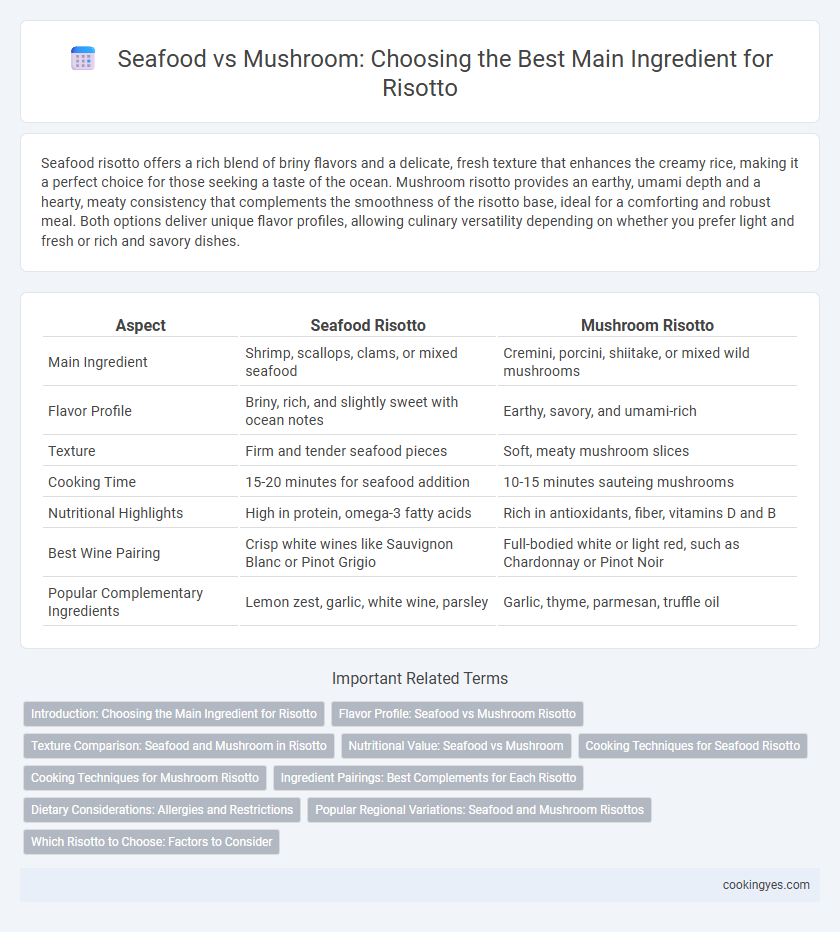Seafood risotto offers a rich blend of briny flavors and a delicate, fresh texture that enhances the creamy rice, making it a perfect choice for those seeking a taste of the ocean. Mushroom risotto provides an earthy, umami depth and a hearty, meaty consistency that complements the smoothness of the risotto base, ideal for a comforting and robust meal. Both options deliver unique flavor profiles, allowing culinary versatility depending on whether you prefer light and fresh or rich and savory dishes.
Table of Comparison
| Aspect | Seafood Risotto | Mushroom Risotto |
|---|---|---|
| Main Ingredient | Shrimp, scallops, clams, or mixed seafood | Cremini, porcini, shiitake, or mixed wild mushrooms |
| Flavor Profile | Briny, rich, and slightly sweet with ocean notes | Earthy, savory, and umami-rich |
| Texture | Firm and tender seafood pieces | Soft, meaty mushroom slices |
| Cooking Time | 15-20 minutes for seafood addition | 10-15 minutes sauteing mushrooms |
| Nutritional Highlights | High in protein, omega-3 fatty acids | Rich in antioxidants, fiber, vitamins D and B |
| Best Wine Pairing | Crisp white wines like Sauvignon Blanc or Pinot Grigio | Full-bodied white or light red, such as Chardonnay or Pinot Noir |
| Popular Complementary Ingredients | Lemon zest, garlic, white wine, parsley | Garlic, thyme, parmesan, truffle oil |
Introduction: Choosing the Main Ingredient for Risotto
Seafood risotto offers a vibrant mix of flavors from shrimp, scallops, and clams that infuse the dish with a rich, briny essence perfect for coastal cuisine lovers. Mushroom risotto highlights earthy, umami-rich varieties like porcini and shiitake, creating a hearty, vegetarian-friendly alternative with deep, satisfying notes. Selecting between seafood or mushroom as the main ingredient depends on the desired flavor profile and dietary preferences, shaping the overall character of the risotto.
Flavor Profile: Seafood vs Mushroom Risotto
Seafood risotto offers a briny and delicate flavor profile, enriched by shellfish and fish that impart subtle oceanic notes and natural sweetness. Mushroom risotto provides an earthy and umami-rich taste, characterized by deep, nutty undertones and a robust, savory complexity from varieties like porcini or shiitake. The choice between seafood and mushroom influences the dish's aromatic intensity and depth, making each version distinct in its savory appeal.
Texture Comparison: Seafood and Mushroom in Risotto
Seafood in risotto offers a tender, slightly chewy texture that contrasts with the creamy rice, enhancing the dish's complexity. Mushrooms provide a firmer, meaty bite with a slight earthiness that complements the risotto's smooth consistency. The choice between seafood and mushrooms significantly influences the overall mouthfeel, balancing creaminess with either softness or bite.
Nutritional Value: Seafood vs Mushroom
Seafood risotto offers high-quality protein, omega-3 fatty acids, and essential minerals like zinc and iodine, supporting heart health and brain function. Mushroom risotto provides dietary fiber, antioxidants, B vitamins, and minerals such as selenium and potassium, promoting immune health and reducing inflammation. Choosing between seafood and mushroom depends on desired nutritional benefits, with seafood excelling in protein and healthy fats, while mushrooms deliver fiber and phytonutrients.
Cooking Techniques for Seafood Risotto
Seafood risotto requires precise timing to prevent overcooking delicate proteins such as shrimp, scallops, or squid, ensuring a tender texture that contrasts with the creamy arborio rice. Techniques include sauteing seafood separately and gently folding it into the risotto near the end of cooking or briefly cooking it within the risotto to marry flavors without compromising texture. Maintaining a simmering broth and constant stirring promotes al dente rice while infusing the dish with rich seafood essence.
Cooking Techniques for Mushroom Risotto
Mushroom risotto requires careful sauteing of mushrooms to enhance their earthy flavors and achieve optimal texture before combining with Arborio rice. Deglazing the pan with white wine and gradually adding warm broth ensures the rice cooks evenly, absorbing rich mushroom essence. Incorporating a mix of wild mushrooms like porcini or chanterelles elevates the dish with complex umami notes, distinguishing it from seafood risotto's delicate, briny profile.
Ingredient Pairings: Best Complements for Each Risotto
Seafood risotto pairs exceptionally well with ingredients like saffron, garlic, and fresh herbs such as parsley or dill, enhancing the briny and delicate flavors of shrimp, scallops, or mussels. Mushroom risotto benefits from earthy additions like thyme, Parmesan cheese, and truffle oil, which amplify the deep umami notes characteristic of porcini, cremini, or shiitake mushrooms. Both variations complement rich broths--fish stock for seafood and vegetable or chicken stock for mushrooms--ensuring the primary ingredient remains the star of the dish.
Dietary Considerations: Allergies and Restrictions
Seafood risotto often poses allergy concerns due to shellfish and fish sensitivities, requiring caution for individuals with seafood allergies or histamine intolerance. Mushroom risotto provides a vegetarian alternative free from common shellfish allergens, suitable for those avoiding animal products or with shellfish restrictions. Both options should consider sodium content and potential sensitivities to ensure safe dietary choices in risotto preparations.
Popular Regional Variations: Seafood and Mushroom Risottos
Seafood risottos are a hallmark of coastal Italian regions like Liguria and Sicily, featuring fresh shrimp, clams, and calamari that imbue the dish with briny, oceanic flavors. In contrast, mushroom risottos, popular in northern regions such as Piedmont and Trentino-Alto Adige, highlight earthy varieties like porcini and chanterelles, providing a rich, umami depth. Both variations showcase local ingredients and culinary traditions, with seafood risotto reflecting maritime heritage and mushroom risotto emphasizing forest-fresh produce.
Which Risotto to Choose: Factors to Consider
Choosing between seafood and mushroom risotto depends on factors such as flavor profile, dietary preferences, and ingredient availability. Seafood risottos offer a rich umami taste with delicate ocean flavors, ideal for those seeking a protein-rich, luxurious dish. Mushroom risottos provide an earthy, savory alternative, suitable for vegetarians and those preferring plant-based meals, while also pairing well with a variety of herbs and cheeses.
Seafood vs mushroom for risotto main ingredient Infographic

 cookingyes.com
cookingyes.com